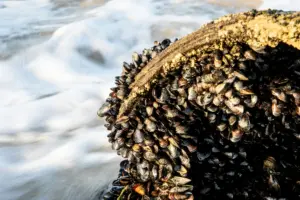Detection of GF microfibers believed to originate from composites in the tissues of oysters and mussels

News has emerged overseas that micro-sized glass fibers (hereinafter referred to as GF) have been found to accumulate in the tissues of oysters and mussels.
The following is the relevant article.
*Reference information
Oysters And Mussels Contain ‘Disturbingly’ High Levels Of Fiberglass, According To A New Study
The source of this reference information is a media outlet that introduces gourmet food and fashion,
but I felt that it was a sharp article in the sense that it was aware of food-related issues.
While it may be sufficient for general understanding,
as it is a general-interest media outlet, the technical details are somewhat lacking.
The aforementioned article is based on a research paper.
Upon reading the paper, I felt the information presented was fragmented,
so I will introduce the content based on the original research paper here.
Researchers from Brighton University collected oysters and mussels from Chichester Harbor to investigate GF microfibers
The literature referenced in the article introduced at the beginning is as follows.
The content is available for anyone to read online.
The motivation for the study was to determine whether GF accumulation in marine organisms is recognized,
and whether there are differences in timing or by tissue type,
using Tukey’s HSD Test, a one-way analysis of variance,
to investigate significant differences in the average GF accumulation levels within organisms.
The first author of the research paper is a researcher at Brighton University,
and the study was conducted on oysters and mussels collected from Chichester Harbor in the UK.
Key points of the research paper
We will touch on the key points for understanding the content.
Sampling of evaluation targets
Ten oysters and ten mussels were used as evaluation targets.
The sizes were 8–10 cm and 6–8 cm, respectively.
The sampling periods were December 2018 for oysters, January 2019 for mussels, and May 2019 for oysters.
After collection, the samples were stored at -20°C to maintain freshness.
Processing of marine organisms and evaluation Sample preparation method
To investigate whether the accumulation of GF microfibers is tissue-dependent,
the samples were divided into digestive glands (liver glands), reproductive glands, and remaining tissues, and the GF microfiber content was investigated.
The separated tissues are each placed in a mixture of 30% H₂O₂ (hydrogen peroxide) and 65% HNO₃ acid solution for 48 hours,
then stirred for 30 minutes in an orbital shaker to completely dissolve the tissues.
The dissolved solution is filtered through stainless steel sieves of 100 μm, 53 μm, and 35 μm,
and these sieves are thoroughly rinsed with distilled water.
This washing solution is placed on a petri dish and dried at 60°C for 24 hours to prepare the evaluation sample.
Observation method for GF microfibers
GF microfibers were counted under a binocular stereomicroscope at a maximum magnification of 20×.
GF microfibers are transparent, making them easy to distinguish from microplastics and other impurities, as described in the text.
Observation results were calculated as the number of GF microfibers per wet weight (mp/kg ww).
Raman spectroscopy analysis
A 785 nm 300 mW air-cooled blue laser with a 1200 lines/mm grating and
a Renishaw InVia Qontor microscope Raman with a CCD array detector were used.
The objective lens magnification was 50x, and the laser output was 5% with 10 accumulations.
The motivation for performing Raman spectroscopy analysis is
to confirm whether the material detected as GF microfibers
is indeed GF.
The broad peak at 1000 to 1200 cm-1 is attributed to the asymmetric stretching vibration of the Si-O-Si bond,
as described in the literature.
It is mentioned that the loss of crystalline regularity causes the peak associated with this vibration, typically observed between 600 and 850 cm-1, to undergo red shift (shifting to the longer wavelength side) and become broad.
The spectral chart is shown in Fig. 2 of the paper.
Based on these results, it seems that the authors wish to argue that the fibers are glass fibers.
GF microfibers found in oysters and mussels
Several important findings were obtained here.
The accumulation of GF microfibers in the body exhibits seasonality
The amount of GF microfibers found in the body was higher in samples collected in winter,
reaching 11,220 mp/kg ww,
while samples collected in May contained approximately 1,380 mp/kg ww.
Among these, GF microfibers found in oysters collected in December 2018
were compared with those from mussels in January 2019 and oysters in May of the same year,
and the results of a one-way analysis of variance showed a significant difference in the mean values.
The author argues that it is clear that December has the highest levels.
ANOVA can be applied not only to evaluating the equivalence of mean values but also to predictive models that consider variability.
This was also covered in a previous series.
※Related column (In Japanese only)
Accumulates easily in the digestive gland but not in the reproductive gland
When examined by tissue type, oysters had the highest GF microfiber content at 6,880 mp/kg ww,
with the highest amount found in the digestive glands at 3,550 mp/kg ww.
Muscle tissue had a content of 1,890 mp/kg ww.
As mentioned earlier, December 2018 had the highest GF microfiber content,
and its average value showed a significant difference compared to other sampling periods.
However, when the evaluation target was limited to the “gonads,” the null hypothesis that December 2018 showed a significant difference compared to other periods for the same target was rejected.
Statistically, this means that there is no significant difference in the average values.
Gonads appear to be tissues where GF microfibers accumulate less easily compared to other tissues.
This result can also be confirmed in the graph in Fig. 4 of the paper.
Next, I would like to discuss the points raised by the author in the paper and
my personal opinion on them.
The impact of GFRP repairs and disposal of GFRP hulls during the winter season
It is suggested that the increase in GF microfiber accumulation during the winter season may be due to an increase in GFRP repairs and disposal of GFRP hulls (mainly boats) for maintenance purposes.
Generally, when repairing a ship’s hull using GFRP, dry glass fibers are cut to the specified dimensions, impregnated with matrix resin, and then laid up.
In some cases, dry fibers are placed directly on the hull and impregnated with matrix resin there, but in either case, it is easy to imagine that handling resin-unimpregnated glass fibers in the open air could lead to glass fiber dispersion.
Therefore, I also believe this argument is valid.
Reasons for the high number of GF microfibers found in digestive glands
While there are descriptions using microplastics as an example,
there is little specific consideration of GF microfibers.
Since glass fibers have a higher density than seawater,
there are descriptions stating that they tend to accumulate along coastlines and on the seabed.
Both oysters and mussels filter seawater through their gills to consume plankton and other organisms.
Since both species inhabit rocky areas, my hypothesis is that GF microfibers are collected either before they settle on the seabed after entering the seawater from the sea surface, or after they have settled on the seabed and are resuspended by wave agitation, and then collected in the same manner.
I would like to seek the opinions of marine biology experts on this matter.
Do GF microfibers cause harm like asbestos?
The paper’s author states that it is still too early to discuss this.
Since asbestos also took a significant amount of time before actual health hazards emerged,
I understand this perspective as requiring both data volume and the passage of time.
Personally, I think the key point to clarify is that
asbestos is primarily inhaled through breathing,
while the current study focuses on GF microfibers found in oysters and mussels,
which are ingested.
This could also be described as the difference between the respiratory and digestive systems.
If we are to have the same discussion as with asbestos,
the impact of dry glass fibers
needs to be examined in terms of its effects on people who use dry fibers on land.
If we consider this issue from the perspective of its impact on health,
the discussion would center on whether consuming marine organisms that have ingested GF microfibers
through their digestive systems could affect human organs, particularly the digestive system.
That is my understanding.
Not only organic microplastics but also
inorganic GF microfibers may become subjects of various evaluations in the future.
Summary
Regarding research on the accumulation of GF microfibers in marine organisms,
this is the first time I have come across it.
The fact that there is a clear seasonal pattern, which seems to correlate with the timing of GFRP repair or disposal work, is personally intriguing.
Additionally, the significant accumulation of GF microfibers near the digestive glands suggests that
oysters and mussels ingested these fibers along with their food.
From an ecosystem conservation perspective, I believe it will be necessary to explore improvements across the entire process of GFRP manufacturing, repair, recycling, and disposal, as well as efforts to utilize fibers that are less prone to dispersion through material-side micro-reduction.



